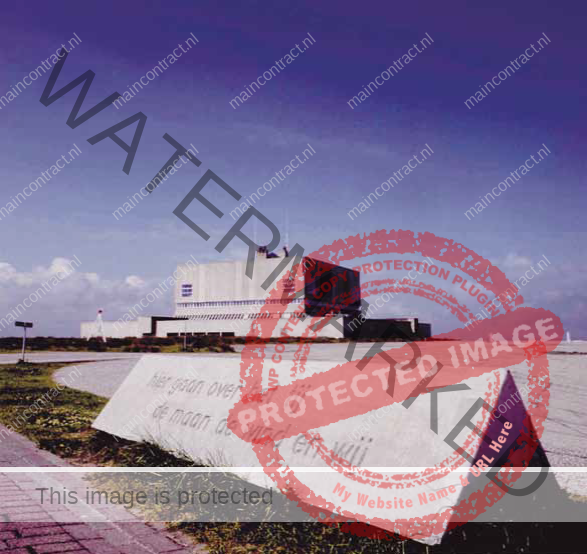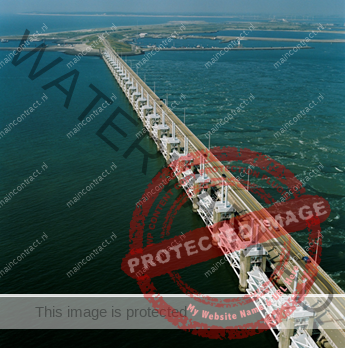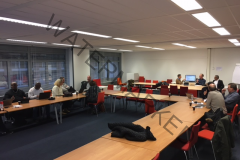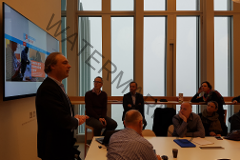ojuist verwijderd
Pagina Inhoud
![]()
Imagine one of the world’s most iconic assets, a marvel of engineering and water management – the Storm Surge Barrier in the Eastern Scheldt estuary, or Oosterscheldekering (OSK). It has been built- and is managed by RijksWaterStaat (RWS), the Asset Management organisation of the Dutch Ministry of Infrastructure and Water Management. It is the culmination of the Delta scheme, a master plan designed after the disastrous February flood of 1953 killing over 1800 people. “No more”, Rijkswaterstaat said. Water Safety is in the DNA of Rijkswaterstaat and this DNA determined our building and design of our water based infrastructure, our maintenance, our Asset Management. But what happens when, not unlike biological evolution, this DNA gradually changes?
After its commissioning in the mid-eighties, the OSK closed 29 times to protect the hinterland. Although the OSK is one-of-a kind in design, RWS manages five other moveable storm surge barriers, all part of the intricate Dutch Water Safety system, all equal in their uniqueness of design yet sharing the same function: to fulfil the two words “no more”. Just recently, on the third of January 2018, for the first time in history, the weather and tidal conditions were so severe causing all barriers to close at the same time. This confirms the correctness of our DNA. But, this historic moment might occur more often due to climate change. It is the Paris Climate Agreement that lighted the spark for evolution. “Sustainability” found its way into RWS’ mission.
![]()
Author: Menno Nagelhout, MSc University of Applied Sciences HU
1st Thesis Supervisor: Diederik van Leeuwen MSc University of Applied Sciences HU
2st Thesis Supervisor: Rob Schoenmaker, PhD TUDelft
Company supervisor Ir. ing. Jan Bosland
At present, RWS is not able to compare the output of Asset Management (AM) activities to reach the different goals following the mission regarding Water Safety and Sustainability. This may lead to poor AM decisions, resulting in probable failure of reaching the set goals regarding Sustainability and/or Water Safety.
Generalizing this, it is a problem of alignment of an organization’s mission statement into different yet comparable goals, especially when a mission statement evolves and the (in)ability to make Asset Management decisions based on this alignment. This problem leads to the main research question:
How can Sustainability be embedded in the Asset Management Strategy in accordance with already embedded goals?
In other words, how can we merge the Water Safety DNA and Sustainability DNA with the aid of an AM Strategy?
This question is answered by applying this problem to the OSK in a case study. The steps that have been taken in order to solve the problem and their results, are:
– Determining of the meaning of “Sustainability” for Rijkswaterstaat, as this can be a very broad concept. It is found that Sustainability within RWS is defined as minimizing the impact of our activities on the earth, resulting in a sustainable living environment through six focus areas, being Energy and climate, Circular economy, Sustainable area development, Sustainable water management, Sustainable accessibility, and Health;
- Determining of the line-of sight for the goals of Water Safety and Sustainability. This part of the research is anchored in the AM standard of the NEN-ISO 55000 series (NEN, 2014). The Line of Sight for RWS is ambiguous and in some aspects over detailed causing overlap in plans and RWS regulations, frameworks placed in the alignment, in other places steps (i.e. plans, regulations, frameworks) are identified in theory but missing practically;
- Determining the current state, presence, or absence of the current AM Policy and – Strategy applicable for the OSK and the position of Sustainability in it; with the aid of given requirements for these two main AM entities given by the NEN-ISO 55000 series and the ‘International Infrastructure Management Manual’ by the NAMS (NAMS, 2011). It is found that RWS has no AM Policy due to absence of key elements of Policy, as describing the way the AM discipline helps RWS to manage the Networks in order to meet the organisational goals, and failing to state principles for development of the AM Strategy. The AM Strategy for Asset class of moveable Storm Surge Barriers is diffuse, incomplete and scattered over different documents that are not aligned. Furthermore, AM Strategy aspects for moveable storm surge barriers focus solely on Water Safety. The required aspects missing, are:
- Consistency: given the ambiguity of RWS’ Line of Sight;
- Life Cycle Approach: as the current Asset Management focuses on the lifecycle delivery phase and Life Cycle Costing (LCC) is not implemented in maintenance programs;
- Framework: as RWS has not adopted the NEN-ISO 55000 series;
- Insight in current- and desired state of the AM Strategy;
- Improvement program (based on performance of AM Strategy).
Fig 1: “here, the tides are ruled, by the moon, the wind and us”
Source: Rijkswaterstaat
- Design of a Balanced Scorecard (BSC) followed by a design of a Comparison System in order to compare the influence of a project, scheme or modification on RWS’ goals of Water Safety and Sustainability. The BSC drafted, consists of four focus areas, in which performance is measured being: Customer, Financial, Internal Business Processes, Learning and Growth. These have been identified for the OSK and placed in hierarchy. An identification has been made of leading and lagging indicators. The Balanced Scorecard (BSC) is a classic performance management tool introduced by Kaplan & Norton in their ‘The Balanced Scorecard: Translating Strategy into Action’ (Kaplan & Norton, 1996). This tooling is, for design of a performance management system within an AM organisation, also proposed by Terry Wireman in his ‘Developing Performance Indicators for Managing Maintenance’ (Wireman, 2005). The leading KPI’s in this Comparison System are:
– Probability of failure on demand (of the OSK);
– Climate and energy: CO2 reduction;
– Circular Economy: energy use reduction;
– Financial: LCC Annual Worth ;
– Financial: Environmental Cost Indicator, i.e. € needed to take counter measures for the carbon footprint of the realization of a project/physical measure. - The Comparison System is designed as a Multi Criteria Analysis, a methodology firmly anchored in the knowledge domain of AM as the NAMS’ ‘International infrastructure Management Manual’ (NAMS, 2011) as AM decision making technique. When multiple attributes contribute to the
188 performance of a system (where a system can also be a certain modification, renewal or maintenance scheme), a 6-step approach is designed, with the BSC as starting point:
Fig. 2: Storm Surge Barrier in the Eastern Scheldt
Source: Rijkswaterstaat
- Define the (K)PIs relevant to System Performance;
- Define the target value and acceptable lowest value, thus defining the target range of the (K)PI. This can be done by data gathering and statistical analysis on this data, yet in most organisations these values are set by management (as is in this RWS case);
- Shift the KPIs to leading and lagging indicators, as only the leading indicators can predict the results of a certain AM decision;
- Organize the leading indicators for the same hierarchal level if applicable (in this case on OSK level);
- Deploy weighting factors to the (K)PIs (sum of which is 1);
- Map the weighted leading indicators per hierarchal level onto a non-dimensional scale in the spider web-graphic form, where each (K)PI represents a point of the web. The sum of the scores per scenario is the “figure of merit”. The scenario (i.e. AM decision) having the largest sum, is the best choice. NB. When one or more (K)PIs score below their target range yet the sum of this scenario is still the largest, the scenario with the (next) biggest sum and all (K)PIs scoring in their range has to be chosen.
The result of this as aid for AM decision making, is shown by figure 3: Steps 2, 5 and 6 are also described by Hall et al. in 3.5 of “A decision-support methodology for performance-based Asset Management, Civil Engineering and Environmental Systems” (Hall et al., 2003). An important note on this designed approach is, that further research is needed in order to determine the weighting factors in step 5. With this Comparison System designed, the performance management system consisting of the Balanced Scorecard and Comparison System have to be integrated into an AM strategy.
- A new AM Strategy has been designed with Sustainability embedded, by determining the current RWS situation for presence of an AM Policy and AM Strategy and the gap with an AM Strategy following literatures’ requirements with the aid of a fit-gap- analysis followed by a SWOT, and containing the performance management system. The AM Strategy designed contains the AM Strategic requirements of the NEN-ISO 55001 (NEN, 2014) and, in addition, “typical contents” of an AM Strategy given by the the ‘International Infrastructure Management Manual’ (NAMS, 2011)
The AM Strategy has been designed for the asset class of moveable storm surge barriers, by generalizing the research results of the OSK case study. This generalization is possible (Mayring, 2007) because of:
- Strategic actions have been defined in the new AM Strategy in order to validate the OSK results for the other moveable storm surge barriers as well;
- Peer validation of the new AM Strategy, in which the key role of Quality manager (QM) moveable storm surge barriers (a role within RWS not confined to a geographical divide in asset portfolio but for all moveable storm surge barriers) forms a linking pin for the other barriers.
- On broader level, validity is given by the research set-up with design of a validation tool (Strategy Compass) and the AM Strategy itself according to literatures’ requirements, anchoring the OSK specific results into literature.
The cost of implementation of the new AM Strategy and thus executing of these actions is appraised at €(xxxx)* for the whole asset class of moveable storm surge barriers. By embedding Sustainability in the AM Strategy, reaching of the Sustainability objectives is managed, resulting in a gross revenue exceeding €(xxxxx) in the years until 2022. The net result is depending on contractors tender documents in these coming years. This figure is solely for the OSK, based on energy prices of energy generated and saved. The qualitative revenue is that by having a clear AM Strategy, with all required aspects in a single medium, managing the alignment becomes more easy, leading to better AM decisions.
Revenues of Sustainability can be higher when numbers of other barriers are taken into account as well, thus needing further research. There are four other suggestions made for additional research, summarized by their proposed main research questions:
- With which weighting factors of the BSC objectives can RWS make AM decisions that are aligned with its organisational mission, vision and strategy?
- What are the ranges of the KPIs in the Balanced Scorecard based on quantitative analysis?
- What is the correlation between a valid, embedded AM Strategy and quantitative revenues?
- What are the implications of implementation of a new AM Strategy for the Rijkswaterstaat organisation?
*Please contact author for financial information
![]()
Conclusion
Analysis (being the Comparison System and Strategy Compass) and the adjustments to the whole AM Strategy could be applied to other RWS assets/asset classes, as well as to other organisations managing capital technical assets in a sustainable way, resulting in a new AM Strategy in accordance with the NEN-ISO 55000 series. With the performance management system consisting of the Balanced Scorecard and Comparison System (both including Water Safety and Sustainability goals) integrated into a new AM strategy for moveable storm surge barriers, the main research question is answered. “Sustainability” from RWS’ mission statement has become an integrated part of the new AM Strategy for the asset class of moveable storm surge barriers. We will still keep our land safe against floods. But, as in evolution, Rijkswaterstaat must adapt to change. We keep saying, “no more”. Yet another fight looms large: Climate Change. Our DNA evolves.
References
1 Hall, J. W., Le Masurier, J. W., Baker-Langman, E. A., Davis, J. P., & Taylor, C. A. (2004). A decision-support methodology for performance-based Asset Management, Civil Engineering and Environmental Systems.
2 Kaplan, R. S., & Norton, D. P. (1996). The Balanced Scorecard: Translating Strategy into Action. Massachusetts, USA: Harvard Business Review Press.
3 Mayring, P. (2007). On Generalization in Qualitatively Oriented Research.
4 NAMS. (2011). International Infrastructure Management Manual (4th ed.). Wellington, New Zealand: National Asset Management Support Group.
5 NEN. (2014). NEN-ISO 55000 series. Retrieved from http://www.nenconnect.nl
6 Wireman, T. (2005). Developing Performance Indicators for Managing Maintenance (2nd ed.). New York, USA: Industrial Press Inc..
Discuss or give your opinionFollow on FacebookFollow on Twitter
Verwante Artikelen
Tags: Article, Assetmanagment, SAMP











